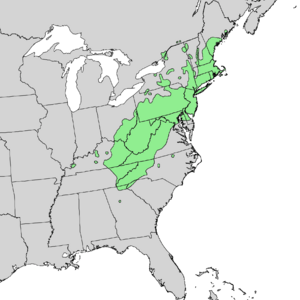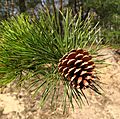Pitch pine facts for kids
Quick facts for kids Pitch pine |
|
|---|---|
 |
|
| Conservation status | |
| Scientific classification | |
| Genus: |
Pinus
|
| Species: |
rigida
|
 |
|
The pitch pine (scientific name: Pinus rigida) is a type of pine tree. It usually grows to be small or medium-sized, between 6 and 30 meters (about 20 to 100 feet) tall. This tree is originally from eastern North America. You can find it from central Maine all the way south to Georgia, and west to Kentucky. It also grows in a couple of spots along the St. Lawrence River in southern Quebec and Ontario. Pitch pines are special because they can grow in places where other trees can't. This includes soils that are very acidic, sandy, or don't have many nutrients. Sometimes, pitch pines can even mix with other pine types, like loblolly pine or shortleaf pine.
Contents
Where Does the Pitch Pine Live?
You'll mostly find pitch pines in the southern parts of the northeastern United States. This includes places like coastal Maine, Ohio, Kentucky, and northern Georgia. There are also a few groups of these trees in southern Quebec and Ontario in Canada.
Pitch pine is known as a pioneer species. This means it's often the first tree to grow in an area after it has been cleared, like after a fire or logging. In very tough conditions, it can be the main type of tree in a forest. But usually, other trees like oaks will eventually take over. This pine tree can live in many different places, from dry, sandy uplands to wet, swampy areas. It can survive in really poor conditions. It's the main tree you'll see in the famous New Jersey Pine Barrens.
How Was the Pitch Pine Named?
The scientific name for the pitch pine, Pinus rigida, was given by a British botanist named Philip Miller. A botanist is a scientist who studies plants. The pitch pine belongs to the pine family, called Pinaceae. It's part of a group known as "hard pines."
What Does a Pitch Pine Look Like?
Pitch pines often have an unusual shape. Their branches are usually twisted, and they don't naturally shed their lower branches very well. The needles grow in bundles of three, called fascicles. They are about 6 to 13 centimeters (2.5 to 5 inches) long. The needles are thick (more than 1 millimeter wide) and sometimes a little twisted.
The cones are about 4 to 7 centimeters (1.5 to 3 inches) long and are oval-shaped. They have small prickles on their scales. The tree trunks are usually straight but might have a slight curve. Their bark is thick and has large, uneven plates.
How Pitch Pines Survive Fires
Pitch pines are amazing at growing back after damage. If the main trunk is cut or burned by fire, new shoots can grow from the trunk. These are called epicormic shoots. This is one of the many ways pitch pines are adapted to survive fires. Another way is their thick bark, which protects the sensitive inner layer of the tree, called the cambium layer, from heat. Trees that have been burned often grow into short, twisted trees with many trunks because of these new sprouts. This special ability also makes them popular for bonsai, which is the art of growing small trees in containers.
Pitch Pine Life Cycle
Young pitch pines grow quickly, gaining about 30 centimeters (one foot) in height each year in good conditions. This fast growth continues until the tree is about 50 to 60 years old, then it slows down. After about 90 years, the tree doesn't grow much taller.
Trees that grow in open areas can start making cones in as little as three years. Pines that grow in the shade take a few more years to produce cones. The cones take two years to fully grow. Seeds are released during the fall and winter. Pitch pines cannot pollinate themselves. These trees can live for about 200 years or even longer!
What is the Pitch Pine's Role in Nature?
Pitch pines provide a home and food for many different animals. Birds like the pine warbler, wild turkey, red-cockaded woodpecker, great-crested flycatchers, blue jays, black-capped chickadees, black-and-white warblers, Nashville warblers, and chestnut-sided warblers use them for cover and for building nests. Deer eat the young seedlings and new sprouts. Small mammals and birds also enjoy eating the seeds from the cones.
How Do People Use Pitch Pines?
Pitch pine is not a main tree for getting timber (wood for building) because its trunks are often crooked or it has many trunks. It also doesn't grow as fast as some other pine trees in eastern America. However, it grows very well in places where other trees struggle.
In the past, pitch pine was a big source of pitch (a sticky substance from trees) and wood. This wood was used for building ships, supports in mines, and railroad ties. This was because the wood has a lot of resin, which helps it last longer and not rot. Because of this, it was also used for big wooden structures, like radio towers.
Today, pitch pine wood is mostly used for rough construction, making pulp (for paper), creating crates, and as fuel. Because it doesn't grow evenly, finding high-quality, long pieces of pitch pine can be difficult and expensive.
Historical Uses by Native Americans
Archaeological findings show that Native American tribes like the Iroquois, Shinnecock, and Cherokee all used pitch pine. The Iroquois used the pitch to help with problems like rheumatism, burns, cuts, and boils. Pitch was also used as a laxative. Both the Iroquois and the Shinnecock used a pitch pine poultice (a soft, moist mass applied to the body) to help open boils and treat abscesses. The Cherokee used pitch pine wood to build canoes and for decorative carvings.
Pitch Pine Hybrids
Pitch pine is known to mix with other pine trees, like loblolly and shortleaf pines. One example is the pitlolly pine (scientific name: Pinus x rigitaeda). This is a natural mix between the loblolly pine and the pitch pine. This hybrid tree gets the tall size of the loblolly pine and the ability to handle cold weather from the pitch pine. The pitlolly pine has been planted a lot in South Korea as a replacement for loblolly pine.
Gallery
-
View north from a fire tower on Apple Pie Hill in the New Jersey Pine Barrens. The vast pine forest is almost entirely made up of Pinus rigida.
Images for kids
-
View north from a fire tower on Apple Pie Hill in the New Jersey Pine Barrens. This huge pine forest is almost completely made up of Pinus rigida trees.
See also
 In Spanish: Pino bronco para niños
In Spanish: Pino bronco para niños








